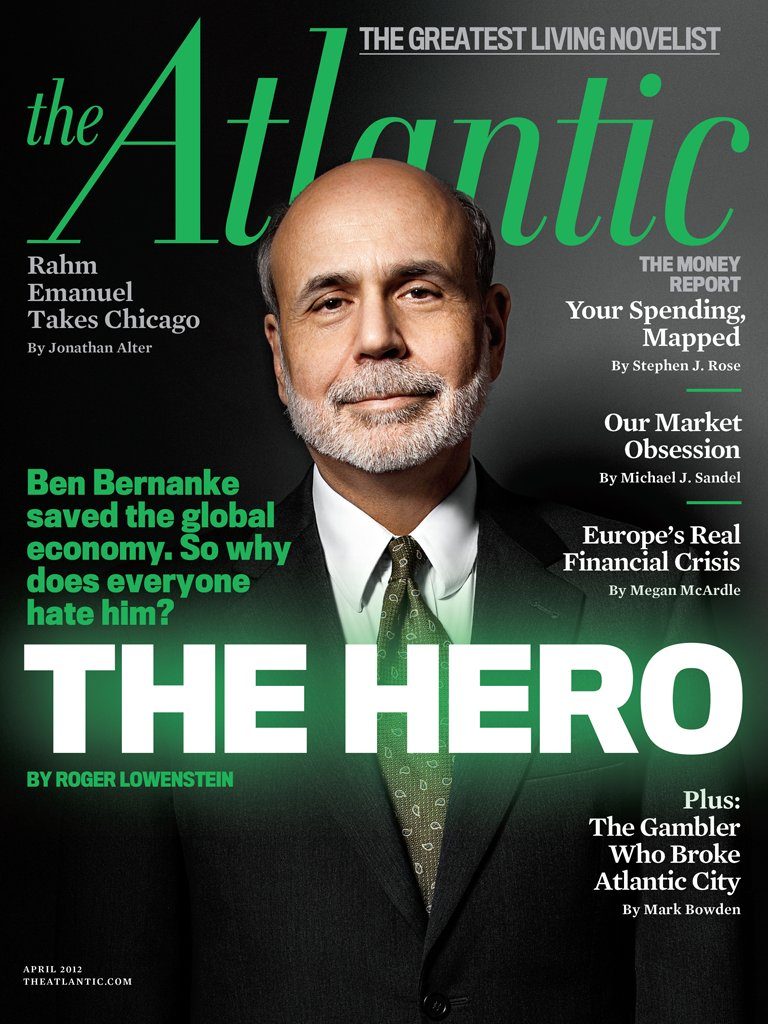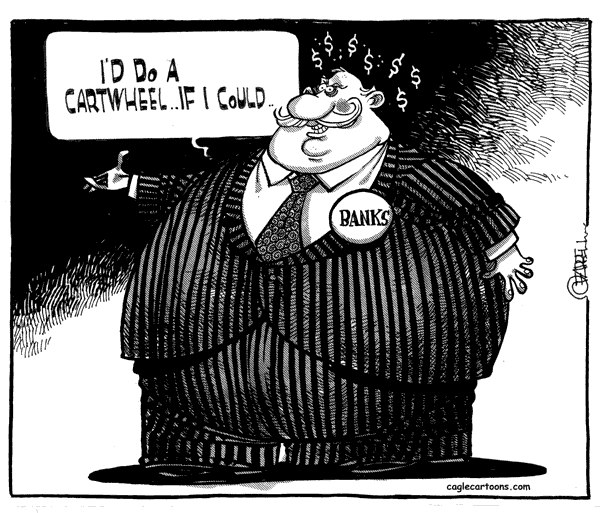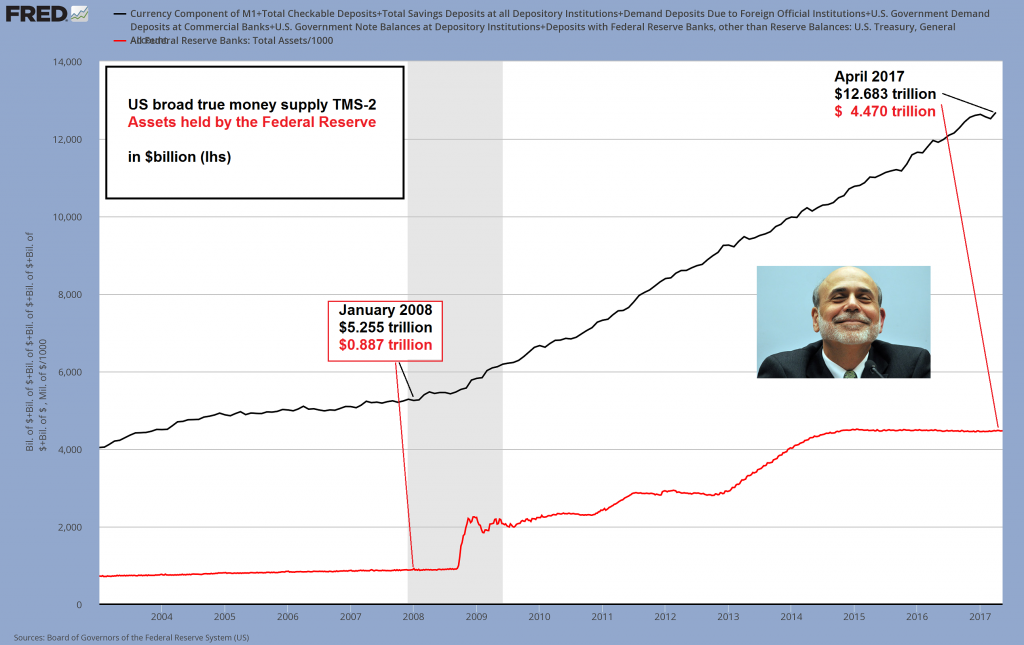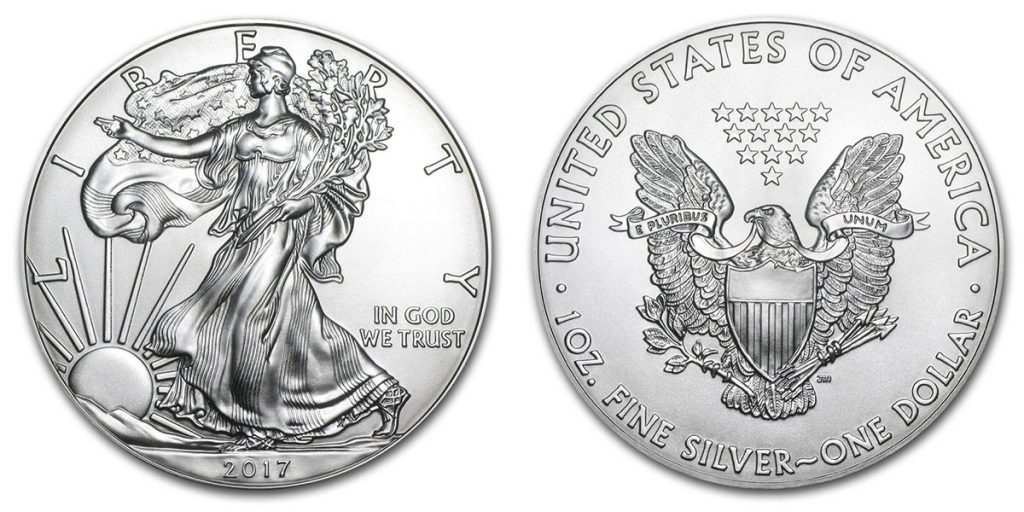Bernanke Redux Somehow, former Federal Reserve Chairman Ben Bernanke found time from his busy hedge fund advisory duties last week to tell his ex-employer how to do its job. Namely, he recommended to his former cohorts at the Fed how much they should reduce the Fed’s balance sheet by. In other words, he told them how to go about cleaning up his mess. Praise the Lord! The Hero is back to tell us what to do! Why, oh why have you ever left, oh greatest central planner of all time. We are not worthy. - Click to enlarge We couldn’t recall the last time we’d seen or heard from Bernanke. But soon it all came back to us. There he was, in the flesh, babbling on Bloomberg and Squawk Box, pushing the new paperback version of his mis-titled memoir “The Courage to Act.” Incidentally, the last time we’d heard much out of the guy was when the hard copy was released in late 2015. With respect to the Fed’s balance sheet, Bernanke remarked that the Fed should cut it from .5 trillion to “something in the vicinity of .3 to .8 trillion.” What exactly this would achieve Bernanke didn’t say. As far as we can tell, a balance sheet of .8 trillion would still be about 300 percent higher than it was prior to the 2008 financial crisis. Bernanke, by all measures, is an absolute lunatic.
Topics:
MN Gordon considers the following as important: Central Banks, Debt and the Fallacies of Paper Money, Featured, newslettersent, Precious Metals
This could be interesting, too:
RIA Team writes The Importance of Emergency Funds in Retirement Planning
Nachrichten Ticker - www.finanzen.ch writes Gesetzesvorschlag in Arizona: Wird Bitcoin bald zur Staatsreserve?
Nachrichten Ticker - www.finanzen.ch writes So bewegen sich Bitcoin & Co. heute
Nachrichten Ticker - www.finanzen.ch writes Aktueller Marktbericht zu Bitcoin & Co.
| Bernanke Redux
Somehow, former Federal Reserve Chairman Ben Bernanke found time from his busy hedge fund advisory duties last week to tell his ex-employer how to do its job. Namely, he recommended to his former cohorts at the Fed how much they should reduce the Fed’s balance sheet by. In other words, he told them how to go about cleaning up his mess. |
|
| We couldn’t recall the last time we’d seen or heard from Bernanke. But soon it all came back to us. There he was, in the flesh, babbling on Bloomberg and Squawk Box, pushing the new paperback version of his mis-titled memoir “The Courage to Act.” Incidentally, the last time we’d heard much out of the guy was when the hard copy was released in late 2015.
With respect to the Fed’s balance sheet, Bernanke remarked that the Fed should cut it from $4.5 trillion to “something in the vicinity of $2.3 to $2.8 trillion.” What exactly this would achieve Bernanke didn’t say. As far as we can tell, a balance sheet of $2.8 trillion would still be about 300 percent higher than it was prior to the 2008 financial crisis. Bernanke, by all measures, is an absolute lunatic. He, more than anyone else, is responsible for the utter mess that radical monetary policies have made of the U.S. economy. He’s the one who dropped the federal funds rate to near zero and inflated the Federal Reserve’s balance sheet by over 450 percent. Yet Bernanke walks and talks with no remorse. He even believes his actions somehow saved the economy. In truth, his actions impeded the economy’s ability to self-correct and provoked today’s asset and debt bubbles. However, with the exception of Lehman Brothers, his efforts did succeed in saving the banker’s bacon. |
|
Big DreamsRemember, it was Bernanke who goaded Alan Greenspan to drop the federal funds rate to 1 percent and leave it there for 12 months in 2003-04 following the dot com crash. This single act contributed to the mortgage lending bubble and bust more than anything else. Bernanke even delivered a fearful speech on the subject in late 2002 auspiciously titled, Deflation: Making Sure “It” Doesn’t Happen Here. There he outlined his approach with uncompromising assurance:
Later, as Fed Chair, Bernanke’s big dream came true. Following the mortgage lending bubble and bust that he’d helped Greenspan orchestrate, Bernanke was granted the opportunity to execute his mad ideas of mass money supply expansion. And then Bernanke looked over all he had made, and behold, it was very good. And he was quite pleased indeed, as he looked out over the endless panorama of his own perfections. As long as he was around and could be consulted, what could possibly go wrong? Why, he would even proffer unsolicited advice if need be. With great precision would he spew forth sacred numbers. The mortals would do well to take heed – click to enlarge. Through his insane quantitative easing policies Bernanke inflated the Fed’s balance sheet from under $1 trillion to over $4.5 trillion. In Bernanke’s mind, this was his great courageous act. We’ve all been living with the results of his courage – low growth, low bond yields, high debt, inflated asset prices, stagnant wages, currency erosion, and more – for nearly a decade. Quite frankly, it stinks. What can you do about it? |
U.S. Broad True Money Supply, 2003 - 2017 |
Silver SecuritySeveral weeks ago, we offered a partial review of how your bank is ripping you off. Today we offer a practical, elegant, way that you can stick it to your banker, the Federal Reserve, and the whole doggone fiat money system. But first, some context courtesy of Dr. Keith Weiner and his recent article titled Will Gold or Silver Pay the Higher Interest Rate?
Gold was selected by traders as the best money to carry large values, especially over long distances. Before gold, they used cattle, because cows move under their own power. Gold does not move itself, but its value density is so high that you can easily carry a fortune in your pocket. Today, gold can be moved anywhere in the world in days. The entire globe is effectively the trading region for gold. This means that gold is not subject to local gluts or shortages. Gold supply and demand are quickly smoothed out over the entire world. This helps makes gold the most liquid commodity. Silver was chosen by wage-earners, not for carrying large value over distance, but to carry value over long periods of time. Before they used silver, they used salt. Salt is not perishable, and it is accessible to even unskilled laborers. Workers need a way to accumulate small amounts of value every month, and store it until needed to buy groceries in retirement. Gold does not work as well for this purpose. An ounce of gold is far too much for most people to buy weekly or even monthly. In smaller sizes, you pay a high premium which will be lost when you sell. Silver offers a better deal for small savers. Silver is the most hoardable commodity. Gold tends to be owned by wealthier people. It is likely that a larger number of people have smaller amounts of silver. The wage-earner who has a modest stack of silver coins does not need interest so much as he needs security.” How to Stick It to Your Banker, the Federal Reserve, and the Whole Doggone Fiat Money SystemIf you already own gold or silver, what follows may seem rather elementary. But if you’re a wage earner and don’t own any precious metals, and don’t know where to start, here’s a practical, elegant, way for you to stick it to your banker, the Federal Reserve, and the whole doggone fiat money system. To be clear, we like to keep things really simple. Thus, we’ve boiled it all down to a simple, two step approach that just about everyone should be able to carry out: Step 1: Go to your nearest ATM and pull out a $20. Step 2: Go down the street to your local coin shop and trade your $20 for a 1-ounce silver eagle. Congratulations! What you’ve just done is trade a dubious debt construct (i.e., a Federal Reserve legal tender scrap of fiat scrip) for a debt free, long term store of value. Do you feel good about your trade? If so, do it again and again. Not only will you be preparing for a highly uncertain future. You’ll also be reducing your implied backing of the corrupt banking and Federal Reserve system by reducing your stake of Federal Reserve scrip notes. Now, we’re not suggesting that you close out your bank accounts. Indeed, a bank account is needed to execute financial transactions under the present system. But this won’t always be the case. In short, we’re encouraging you to store up and accumulate some real wealth given the possibility that your bank – and your deposits – may not be there at some point in the future. Most likely, your deposits won’t be there at precisely the moment when you need your money the most. Contrary to what Fed Chair Janet Yellen says, everything is not awesome. As an aside, last we checked, silver was running about $16.30 per ounce. So, a $20 should cover the cost of the 1-ounce silver coin and the dealer premium. Now what are you waiting for? Take action today! |
Tags: central banks,Featured,newslettersent,Precious Metals




